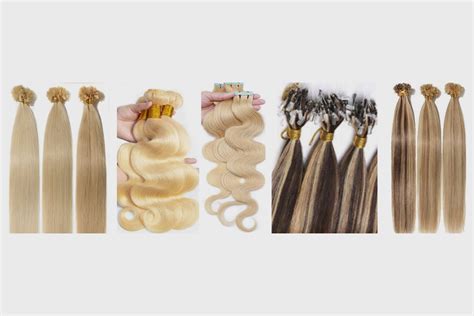What are Hair Extensions?
Hair extensions are supplementary hair pieces that are attached to your natural hair to add volume, length, and/or color. They have become increasingly popular in recent years, with an estimated 33% of women in the United States using them.

Types of Hair Extensions
The vast array of hair extensions available can be overwhelming. To help you navigate this complex landscape, here’s a comprehensive breakdown of the most common types:
1. Clip-In Hair Extensions
- Description: Temporary extensions secured with clips.
- Benefits: Instant transformation, easy to apply and remove.
- Drawbacks: Can be visible if not applied properly.
2. Tape-In Hair Extensions
- Description: Applied with adhesive tape.
- Benefits: Seamless appearance, long-lasting.
- Drawbacks: Professional installation required, can be uncomfortable.
3. Sew-In Hair Extensions
- Description: Sewn into your natural hair using a needle and thread.
- Benefits: Secure and long-lasting, can add significant volume.
- Drawbacks: Can cause damage to natural hair, requires professional installation.
4. Bonded Hair Extensions
- Description: Attached using keratin or cold fusion bonds.
- Benefits: Strong and durable, natural-looking.
- Drawbacks: Professional installation and removal required, can be expensive.
5. Micro Loop Hair Extensions
- Description: Applied with tiny metal rings.
- Benefits: Secure and invisible, long-lasting.
- Drawbacks: Requires professional installation, can be time-consuming.
6. Ponytail Hair Extensions
- Description: Secured with a clip or elastic band.
- Benefits: Adds instant length and volume, easy to apply.
- Drawbacks: Can be bulky, may not be suitable for all hair types.
7. Halo Hair Extensions
- Description: Worn around the head like a headband.
- Benefits: Comfortable and easy to wear, adds volume.
- Drawbacks: Can be difficult to blend with natural hair.
Choosing the Right Hair Extensions
Selecting the right hair extensions depends on your desired outcome and lifestyle. Consider factors such as:
- Length and volume you want to achieve.
- Hair texture and color.
- Budget and maintenance requirements.
- Your hair’s health and condition.
How to Apply Hair Extensions
Applying hair extensions requires skill and precision. It’s highly recommended to seek professional help for any permanent or semi-permanent extensions. However, if you choose clip-in extensions, follow these steps:
- Brush your natural hair.
- Section off the hair you want to extend.
- Position the clip-in extension at the root of the section.
- Snap the clips shut to secure the extension.
- Repeat for all sections.
Common Mistakes to Avoid
- Overusing hair extensions.
- Choosing extensions that don’t match your natural hair.
- Using low-quality extensions.
- Not properly maintaining extensions.
- Not seeking professional help for permanent extensions.
Tips for Styling Hair Extensions
- Use heat protectant spray before styling.
- Avoid over-washing extensions.
- Brush extensions regularly with a soft brush.
- Use special hair care products designed for extensions.
Inspiring Applications
Hair extensions are not just for special occasions. They can also be used for:
- Volume enhancing: Add fullness to fine or thinning hair.
- Color correcting: Add highlights or lowlights without damaging your natural hair.
- Protective styling: Braid or bun extensions over natural hair to prevent breakage.
- Hair loss concealment: Cover up areas of hair loss due to alopecia or medical treatments.
Conclusion
Hair extensions offer endless possibilities to transform your appearance. With the wide range of types available, you can achieve the desired length, volume, and color to suit your style. By following the steps provided and avoiding common mistakes, you can enjoy beautiful, long-lasting hair extensions that will enhance your confidence and overall look.
| Type | Application | Duration | Maintenance | Cost |
|---|---|---|---|---|
| Permanent (Sew-In, Bonded, Micro Loop) | Professional installation required | 3-6 months | Requires regular touch-ups | $1,000-$3,000 |
| Temporary (Clip-In, Tape-In, Ponytail) | Can be self-applied | 1-3 days | Minimal maintenance | $100-$500 |
| Hair Type | Source | Benefits | Drawbacks |
|---|---|---|---|
| Human Hair | Donated human hair | Natural look, blends well | Can be expensive |
| Synthetic Hair | Artificial fibers | Affordable, durable | Can look artificial |
| Remy Hair | Human hair with cuticles aligned | Smooth and tangle-free | Can be expensive |
| Virgin Hair | Unprocessed human hair | Highest quality, but can be difficult to bleach |
| Task | Frequency | Purpose |
|---|---|---|
| Washing | 7-10 days | Remove dirt and oil |
| Conditioning | After washing | Moisturize and detangle |
| Drying | Air dry or blow dry on low heat | Prevent heat damage |
| Brushing | Daily | Distribute oils and prevent tangles |
| Styling | Use heat protectant | Minimize heat damage |
| Problem | Cause | Solution |
|---|---|---|
| Tangling | Friction | Brush extensions regularly |
| Shedding | Poor quality extensions | Use high-quality extensions |
| Itching | Adhesive or clips | Remove extensions and wash the scalp |
| Breaking | Over-pulling or heat damage | Be gentle with extensions and use heat protectant |
| Discoloration | Chlorine or saltwater | Rinse extensions with fresh water after swimming |
